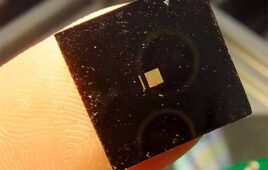
MIT researchers have designed MRI sensors that form clusters in the presence of calcium, allowing them to monitor neuron activity in the living brain. [Image from MIT]
Calcium ions are known to be directly linked to neuronal firing, which is different from the changes in blood flow that other MRI sensors detect. The new sensing method from MIT could let researchers link brain functions to their patterns of neuron activity to determine how different brain regions can communicate with each other while performing certain tasks.
“Concentrations of calcium ions are closely correlated with signaling events in the nervous system,” Alan Jasanoff, senior author of the study, said in a press release. “We designed a probe with a molecular architecture that can sense relatively subtle changes in extracellular calcium that are correlated with neural activity.”
The researchers tested the method in rats and showed that the calcium sensor was able to accurately detect changes in neural activity that are induced by chemical or electrical stimulation deep in the brain.
An MRI allows doctors to see what parts of the brain are active during specific tasks. The most common type is functional MRI which measure blood flow in the brain as an indirect marker of neural activity. The researchers wanted to find a way to map those patterns with specificity and a resolutions that the most common MRI techniques couldn’t provide.
“Methods that are able to map brain activity in deep tissue rely on changes in blood flow, and those are coupled to neural activity through many different physiological pathways,” Jasanoff said. “As a result, the signal you see in the end is often difficult to attribute to any particular underlying cause.”
Calcium ions rush into a cell when a neuron fires electrical impulses. Neuroscientists have been using fluorescent molecules to label the calcium in the brain and image it with microscopy for nearly a decade. This method tends to be limited to a small area of the brain.
The MIT method images calcium using an MRI to analyze larger tissue volumes. To create the new imaging method, the researchers designed a sensor that can detect subtle changes in calcium concentration outside of cells. The sensor can then respond in a way that can be detected by the MRI.
The sensor features two types of particles that cluster together when near calcium. The first particle is a naturally occurring calcium-binding protein called synaptotagmin. The second is a magnetic iron oxide nanoparticle that is coated in a lipid that can bind to synaptotagmin when in the presence of calcium.
When the calcium binds to the particles, the particles group together and appear darker on an MRI image. If there are high levels of calcium outside of the neurons, that indicates low neuron activity. If the calcium levels drop, that means that the neurons in that area are firing electrical impulses.
To test the sensors, the researchers injected them into a part of the brain known as the striatum in rats. The striatum is responsible for planning movement and learning new behaviors, according to the researchers. The rats received a chemical stimulus that creates short bouts of neural activity. They found that the calcium sensor showed the activity and that the sensor could pick up activity created by electrical stimulation.
“Although we have accumulated sufficient knowledge on intracellular calcium signaling in the past half-century, it has seldom been studied exactly how the dynamic changes in extracellular calcium contribute to brain function, or serve as an indicator of brain function,” Xin Yu, a research group leader at the Max Planck Institute for Biological Cybernetics in Tuebingen, Germany, who was not involved in the research, said. “When we are deciphering such a complicated and self-adapted system like the brain, every piece of information matters.”
The researchers are now working on modifying the sensor so that it can spread throughout a larger portion of the brain and pass through the blood-brain barrier. They hope that the sensor will map patterns of neural activity with greater precision than currently possible.
The research was published in the journal Nature Nanotechnology and was funded by the National Institutes of Health and the MIT Simons Center for the Social Brain.




